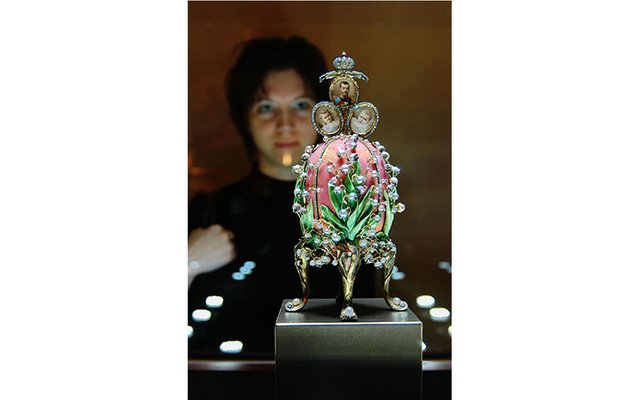Where to see the Fabled faberge Easter egg
Most people get chocolate bunnies or plastic candy-filled eggs as presents on Easter, but for Russian czars at the turn of the 20th century, gifts were lot more expensive—and much less edible. In 1885, Czar Alexander III commissioned 38-year-old Carl Faberge and his St. Petersburg family jewelry business to produce a surprise Easter gift for his wife, Empress Marie Fedorovna. Fabergé designed a beautiful white enamel egg encasing a gold “yolk,” with a pure gold hen enclosed inside like a Russian nesting doll. Inside the hen was a mini diamond replica of the royal crown and a tiny ruby egg pedant.
https://thumbs-prod.si-cdn.com/_1q-x51qq45DLx-3rQokabLqJPE=/800x600/filters:no_upscale()/ as the “Hen Egg,” it became the first of 50 Fabergé Imperial eggs produced over 32 years. The violent Russian revolutions of 1917 saw the end of this extravagant tradition, with the czars overthrown, the Fabergé family fleeing Russia and many of the eggs confiscated by the Bolsheviks.
Today, these rare, million-dollar Easter eggs have found their way into collections, museums and institutions across the world, from Moscow to Cleveland. For example, the Hen Egg is now part of the Vekselberg Collection (named for Russian oil and metal mogul Viktor Vekselberg, who purchased nine eggs from the Forbes family in 2004), and currently housed in the Fabergé Museum in St. Petersburg, Russia.
Not all of the eggs have been located, however, and seven are currently thought lost to history. Until 2015, that number was believed to be eight. Another egg came to light after a scrap metal dealer perusing a flea market in the American Midwest came upon a gold egg on an intricately designed stand. Inside was a gold clock with diamond-encrusted hands. Thinking he could make at least a few hundred dollars profit by melting it down and selling the gold, he purchased the item for $14,000. Despite his rather large investment, potential buyers told him the gold wasn’t worth what he paid. The man (who has remained anonymous) left the egg in his kitchen, thinking he had just thrown $14,000 away, until one day he got curious enough to Google the name on the back of the clock—“Vacheron Constantin.” After a bit more digging, he came upon this 2011 Telegraph article about the Third Imperial Easter Egg. That’s when he discovered this gold egg wasn’t worth $14,000; it was worth millions. Here are the locations of six other Fabergé Imperial Easter eggs:
1898 Lilies of the Valley Imperial Egg
image: https://thumbs-prod.si-cdn.com/hBOvTwI9zZIzyR0AOmilV215sc8=/800x0/filters:no_upscale()/
(Velikzhanin Viktor/ITAR-TASS/Corbis)
One of the objects Viktor Vekselberg purchased from Forbes in 2004, this egg was made in 1898. Given as a gift by Tsar Nicholas II to his wife, Empress Alexandria Fyodorovna, the portraits are of Tsar Nicholas and their two daughters together. This is the rare egg where the surprise isn’t on the inside, but rather elevates out by twisting a gold-mounted pearl button. While this image shows the egg in Moscow, it is currently on display at the Fabergé Museum in St. Petersburg, which can also be toured virtually.
Read more: https://www.smithsonianmag.com/travel/where-you-can-see-fabled-imperial-russia-faberge-eggs-180954863/#Jz4vFPS3Fai9HCMy.99
Give the gift of Smithsonian magazine for only $12! http://bit.ly/1cGUiGv
Follow us: @ekpenyong